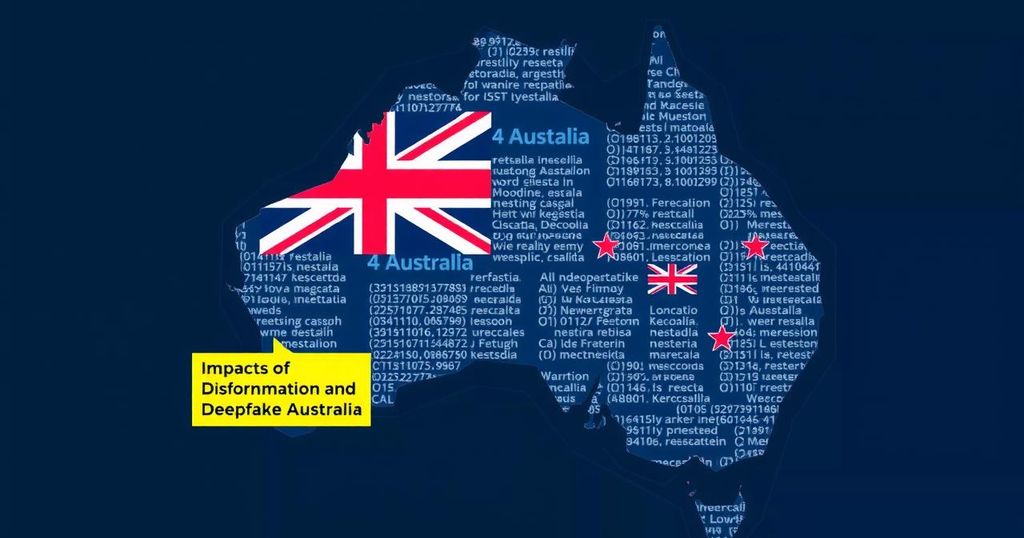The Threat of Deepfakes and Disinformation to Democracy: Lessons for Australia
Disinformation and deepfake technology significantly influenced the recent U.S. elections, posing substantial threats to democratic integrity. AI has simplified the creation of deceptive content, making it increasingly difficult for individuals to distinguish between real and manipulated videos. As Australia prepares for its own elections, the potential for similar disinformation campaigns looms large, necessitating heightened public awareness and solutions to combat this emerging challenge.
The United States recently witnessed the alarming impact of disinformation and deepfake technology during the election cycle. Numerous AI-generated fake images and videos circulated online, particularly those disseminated by supporters of former President Donald Trump, falsely depicting Vice President Kamala Harris. Among the concerning instances were deepfake videos that altered reality, creating fabricated scenarios that could mislead viewers. A particular warning came from Microsoft regarding Russian actors consistently producing these manipulated videos, demonstrating the tangible risks deepfakes pose to democratic integrity.
With the emergence of AI, the processes of creating and sharing deepfake content have become alarmingly simple and widespread. This trend is troubling for democratic nations, including Australia, particularly as the nation approaches its own elections. As Australians struggle to discern truth from fiction, studies indicate that individuals recognize deepfake facial images only half the time and face an even steeper challenge with videos. The challenge intensifies on social media, where video compression further complicates detection efforts.
Deepfake technology has shown it can easily misrepresent political figures without consequence, as also indicated by former Home Affairs Minister Clare O’Neil’s warnings regarding its implications for democracy. Various attempts to satirize leaders have emerged, underscoring the potential for serious misuse rather than mere humor. Political deepfake videos exacerbate public uncertainty and erode trust in news, particularly concerning microtargeting strategies used to manipulate specific audience vulnerabilities.
Not surprisingly, the demographic impact reflects differing susceptibility levels; older Australians face notable challenges in detecting deepfakes, with detection accuracy decreasing significantly with age. Although younger individuals may navigate social media and discern misinformation more effectively, they too are at risk from algorithmic echo chambers reinforcing existing biases. Hence, while advanced AI tools attempt to mitigate the spread of such disinformation, improving public awareness emerges as a crucial defense against the threats deepfakes pose to electoral integrity.
The intersection of misinformation and advanced technology, particularly deepfakes, is emerging as a critical threat to democratic processes worldwide. The recent U.S. elections highlighted this issue where AI-generated content was manipulated to misrepresent candidates and their statements, impacting public perception. With similar vulnerabilities existent in Australia as it approaches its electoral cycle, understanding the ramifications of deepfakes and the difficulty in discerning reality has become paramount. The historical tendency for humans to trust visual representations without skepticism complicates the landscape as deepfake technology continues to evolve at an alarming pace. Studies indicate a pervasive inability among the general public to accurately spot these fabrications, which has profound implications for democratic engagement and electoral integrity.
In conclusion, the rise of disinformation through deepfakes poses a serious threat to the foundations of democracy, especially in light of recent events in the United States. With a similar electoral landscape emerging in Australia, it becomes essential to foster public awareness and education about deepfakes and misinformation. The pitfalls of misled perceptions, coupled with the deceptive power of visual media, necessitate a proactive approach to safeguard democratic processes. As technological advancements continue, understanding and combating the spread of deepfakes is crucial for maintaining a fair electoral system.
Original Source: theconversation.com




Post Comment